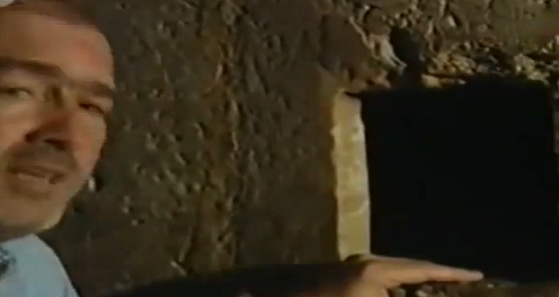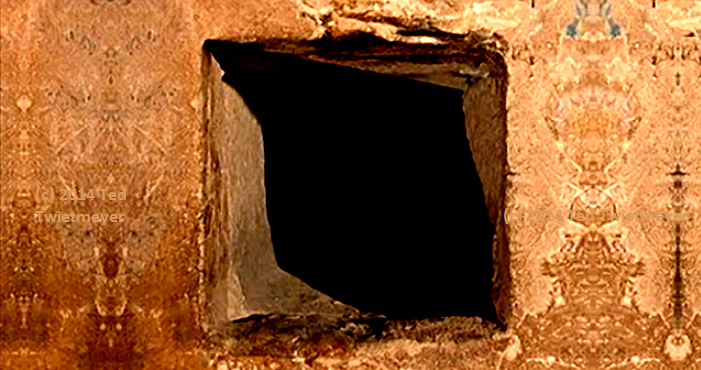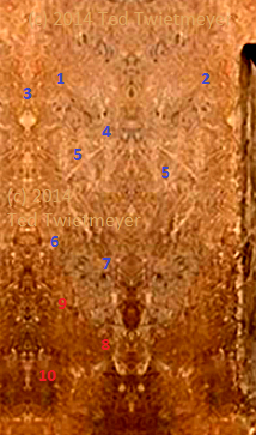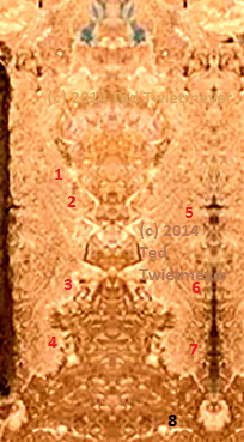![]()
.
Great Pyramid - The Queen's Chamber Wall By Ted Twietmeyer |
It has been endlessly stated that the Great Pyramid has no usable markings, hieroglyphs, etc... to clearly state who built it and for what purpose. To date the Great Pyramid is only known to have “Khufu” written in red on a block in a pressure relieving chamber, high above the King's chamber and some hieroglyphs found written in red in a chamber behind a small door. But is this really all there is? None of these markings really tell us who the builders were or even what they looked like. I recently discovered some amazing images on the wall of the queen's chamber, which no one has talked about or discussed to date. If these figures date back to the time of the pyramid builders, it will result in revelations about who they were. This article may be able to answer at least one important unanswered question: What the ancient people's light source to build the pyramids looked like. In 1872, William Dickson revealed two ventilation shafts in the queen's chamber. Very few closeup photos exist of these queen's chamber air shaft entrances. We will use the term air shaft for identification purposes of these tunnels. Actual function of these two tunnels is not yet known. Perhaps most archeologists and researchers are concentrating on what may be in these air shafts and how far upward these ascend. This article will focus only on images on the wall of the chamber around one of the air shafts, which may be more important than the air shaft itself. Photo below shows the opening of one shaft in the queens chamber, which measures only about 8 inches across. Both air shafts in the queen's chamber are about the same size.
Various descriptions of the air shafts on the web incorrectly describe these openings as slightly over 2 meters across (about six feet.) Clearly a dimension of 2 meters for either shaft opening is absolutely wrong, as seen in figure 1. If air shaft openings were that large, robots would not be needed to explore them. In 1993, Rudolph Gantenbrink sent the first robot in to clean one of the air shafts. One air shaft found a dead end, but in the other air shaft he encountered what some describe as a small stone door with two copper fittings and could proceed no further. A few years later another robot was sent up this same air shaft. It was equipped to drill a small hole through the door and insert a camera through the hole. A very small space or cavity was found behind the door. Could there be information hidden in the pyramid hidden in sight which might tell us something about the people who lived during the construction of the pyramid? Who were these people and what did they look like? On the wall around the air shaft opening shown in a video, I have found graphics which contain a surprising amount of information. Video which shows this opening does not talk about the wall. Since the queen's chamber is kept dimly lit around the clock, even while the robot teams worked in the room, it may be possible graphics and images have been simply overlooked. Watermarks were added to my images due to plagiarism. These marks have been made as unobtrusive as possible:
sible in the original photograph. This is a different air shaft than the one shown in figure 1.
Figures below (1) and (2) strongly resemble alien gray type beings. Like gray beings, each figure has large heads with small facial features and very thin limbs. Immediately below (3) appears a faceless being or robot-like object (4.) Half of a mirrored image of this object appears directly to the right, on the edge of the shaft opening. Limbs radiate downward and outward (5 and 5.) Creatures appear to be facing object or being (3) at the center. Perhaps this object or being is in control of everything. It appears to have a head-like structure (4) which rises above the other creatures on each side. (6) This image strongly resembles a female face similar woman in the near east, possibly wearing a tiara or a crown. Could this person have been a ruler? Figure appears to have very small arms, legs and torso when compared to head size. (7) Shows a 3 layer, 3D stack.
This figure appears to be connected in some unknown way to the face or
head below it (8) which appears to have a head-dress. Dark figure on the
head-dress resembles a bat or other creature which appears to have long
ears. (9) may be the top of a spider's abdomen. Several species of spiders living today have a similar smiley-face on top of the abdomen. (10) Similar to a lobster or crayfish.
Wall appears to depict real objects and beings. Many objects are perfect mirror images of other objects shown:
Area at top of image shows two mirrored areas colored with gray, yellow, violet and blue-green paint or pigment. These colors may be all that remains of original colored pigment when the Great Pyramid was built. Colors may be from a test restoration of the wall with paint. (1) through (4) appear to show a number of “faces” which appear stacked on top of one another. (5 and 6) show a tall object which looks like a post lamp. Note the tiny white dot (5) in the center of a globe-like structure in the lamp housing at the top. This image may be showing us that the people used for lighting during construction of the pyramids or for lighting in everyday life. If this really is a post lamp, it helps to answer a nagging age-old question about how the ancients built the pyramids and carved hieroglyphs on the walls of tombs - without coating the walls with soot from burning torches. Post light appears to bear a resemblance to catalyst-type gas lamps used today which burn natural gas, propane or kerosene gas. Perhaps this post lamp was actually a type of electric light. A replica of the ancient Baghdad battery was built and tested, which proved battery technology has been known for centuries by ancient people. It is not known how far back in time electricity has been used. A group of objects appears to be stacked on the lamp's pole (7) near the bottom of the lamp post. These may simply be decorations, or where electric power or burnable gas is generated. White object (8) appears to be the base of the post lamp. These images show very fine detail which altogether are about eight inches tall, do not appear to be carvings. Even the globe or glass of the post lamp globe is perfectly illustrated by showing a slight loss of transparency, much like how any artist today would paint it. SUMMARY Images on the wall on both sides of the air shaft look more like photographs etched into the stone instead of carvings. If true then these images raise yet another question which remains unanswered: What technology (other than chisels) did the ancients have that could create these images? Until 1872, both queen's chamber air shaft openings were hidden behind thin stone plates. This is when William Dickson removed the stone plates. Dickson probably tapped on the walls with a hammer or other object and found the two hollow locations for the air shafts. Hopefully artwork was not lost on those stone plates. There may have images which connect the scenes on the two sides of the air shaft, unless these two plates were saved and ended up in the Cairo or British museums. Figures and head-dress of these people look like art of the ancient near east, not Egypt or Africa. Perhaps a ancient art expert or anthropologist could confirm this theory. Artwork used construction, whether past or present is always has a reason. Images on the wall were probably put there to tell us something about these ancient people and who they were. Surely they knew their pyramids would exist until the end of time. Depictions of people on the wall also raise another question: If images of ancient people were deemed important enough to be placed on the wall of the Great Pyramid, then why are no names shown on the wall identifying who these people were? Perhaps there is a reason. Consider how we do something like this today in a far simpler way. People often put a framed or unframed 8 x 10 photo of the president they get free from the white house on their walls without ever thinking about it. Millions of these presidential prints hang on walls in homes and offices without and any text or caption stating who the president is. It is assumed that everyone already knows who the person on the wall is. This may be true for people in our era. But what about people who find these photos 500 years from now in a attic? If someone showed you a photo of the fifteenth, eighteenth or twentieth president of the United States, would you know who they are? Now imagine the difficulty of identifying a photo 5,000 years from now. For ancient people thousands of years ago, creating unlabeled images of famous or iconic leaders using various art forms may have quietly taken place throughout history. Perhaps ancient people assumed even people living in the future would readily recognize famous, ancient people or beings are without a caption. There are just too many images and objects on this wall deep inside the Great Pyramid to be written off as irrelevant by archeologists. What other discoveries await? Ted Twietmeyer © 2014 |
| Donate
to Rense.com
Support Free And Honest
Journalism At Rense.com |
Subscribe
To RenseRadio!
Enormous Online Archives,
MP3s, Streaming Audio Files,
Highest Quality Live Programs |



